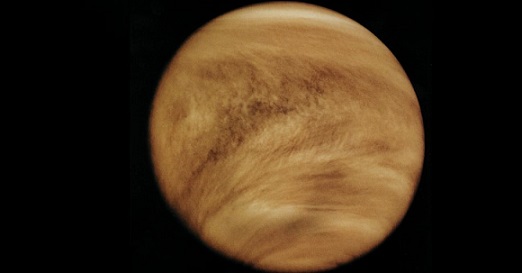
Earth's "twin sister" Venus. A NASA image
BENGALURU (PTI): India has moved a step closer to its maiden mission to Venus with its space agency ISRO announcing that proposals have been sought for space-based experiments to study the planet.
The Announcement of Opportunity (AO) is for space experiments by institutions in the country, and the last date for receiving the proposals is May 19, 2017, the Bengaluru-headquartered Indian Space Research Organisation(ISRO) said.
Those sending the proposals may be currently involved in planetary exploration studies, or development of science instruments for space, or willing to develop the experiments, ISRO said in an announcement on its website.
Though no time-frame has been set by the space agency for the ambitious mission, indications are that the Indian Venusian orbiter mission may not happen before 2020.
The maiden mission to Venus, the second planet of the Solar System named after the Roman goddess of love and beauty, is in all probability going to be a modest orbiter mission.
ISRO Chairman A S Kiran Kumar had earlier said that the mission to Venus is on the horizon and studies are underway.
"Beyond that, Mars second mission and Venus mission are all on the horizon, we have to go through the various studies and then formulate, get the approval and move. Right now, they are all in the study phase," he said while referring to the two new bold inter-planetary sojourns to Earth's immediate neighbours.
Venus is often described as the "twin sister" of the Earth because of the similarities in size, mass, density, bulk composition and gravity.
It is believed that both planets share a common origin, forming at the same time out of a condensing nebulosity around 4.5 billion years ago.
Stating that exploration of Venus began in the early 1960s, ISRO said the planet has been explored by flyby, orbiter, a few lander missions and atmospheric probes.
ISRO said that in spite of great progress made in exploring Venus, there still exist gaps in our basic understanding about surface/sub-surface features and processes, super rotation of Venusian atmosphere and its evolution and interaction with solar radiation/solar wind.
The planet is around 30 per cent closer to the Sun as compared to Earth, hence resulting in much higher solar flux.
Pointing out that the payload capability of the proposed satellite is likely to be 175 kg with 500W of power, the space agency said these values are to be tuned based on the final configuration.
The proposed orbit is expected to be around 500 x 60,000 km around Venus, and the orbit is likely to be reduced gradually, over several months to a lower apoapsis, it said.
The point on an orbit which is closest to the orbited body is called the periapsis and the furthest point is the apoapsis.
A mission to explore Venus was first mentioned in the Department of Space demands for grants 2017-18.
Scripting space history, India on September 24, 2014, had successfully placed its low-cost Mars spacecraft in orbit around the Red Planet on its very first attempt.
ISRO is expected to launch its second lunar mission Chandrayaan 2 during the first quarter of 2018.
It will be another feather in the cap for India if ISRO's mission to Venus turns out to be successful.
On a visit to India in February, Michael M Watkins, Director of the Jet Propulsion Laboratory of NASA, said a mission to Venus is very-very worthwhile as so little is understood about that planet and NASA would definitely be willing to partner in India's maiden voyage to the planet.
Towards that, NASA and ISRO have already initiated talks in February on trying to jointly undertake studies on using electrical propulsion for powering this mission.
India's original inter-planetary dreamer K Kasturirangan, former chairman of ISRO, says, "India should be part of this global adventure and exploring Venus and Mars is very worthwhile since humans definitely need another habitation beyond Earth."
 Previous Article
Previous Article Next Article
Next Article













The Indian Air Force, in its flight trials evaluation report submitted before the Defence Ministry l..
view articleAn insight into the Medium Multi-Role Combat Aircraft competition...
view articleSky enthusiasts can now spot the International Space Station (ISS) commanded by Indian-American astr..
view article